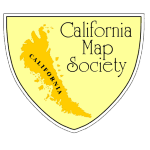LE NOUVEAU MEXIQUE ET LA FLORIDE ...
Dutch dominance of European cartography ended in the mid-1600s with the ascendancy of the French. Nicolas Sanson profoundly influenced his country's map making and established a cartographic family dynasty.
A map's title, makers, date and other relevant information are commonly placed in a cartouche, such as the elaborately framed one abutting this map's top margin just to the right of the midline. (Cartouche Close-up) This map was printed from an engraved copper plate in 1656 and subsequently reprinted several times. When the Sansons relocated their shop, they hammered out portions of the cartouche and re-engraved their address and, sometimes, the date. On the original, one can see traces of the prior addresses. It is possible to track the sequence of reprintings through the re-engravings.
This map shows the claims of several powerful European sovereignties over what is now the United States. France claimed the territory in the upper right that is outlined by yellow and denoted CANADA OU NOUVELLE FRANCE. The English claimed VIRGINIE. The Spanish claimed FLORIDE ESPANGNOLE (outlined in orange in the lower right),NUEVO MEXICO/NEUVA GRANADA (outlined in green in the middle and left), NOUVELLE ESPAGNE (outlined in yellow in lower middle) and CALIFORNIE ISLE (outlined in orange at the left). The island of California tended to follow one of several models, which are distinguishable by the shape of the short northern coastline. The rather flat coastline of Brigg's map was the model until 1656, when Sanson showed the coastline with several significant indentations. Sanson's shape was copied by others. (You can access an image and story about the Brigg's map from the Images & Stories page.) The map also includes several geographic misconceptions. One is the location of the Appalachian Mountains. (For a close-up of this mountain chain, click on the appropriate hyperlink to the right of the image.) Rather than paralleling the eastern coast, the mountains are shown as beginning in the Southeast, extending westward toward the middle of the continent, and swinging southward towards what is now Texas. Such a route chain would cut across much of the Mississippi River basin and block the flow of the great river to the Gulf of Mexico. Another misconception involves the Rio del Norte, which is shown draining a non-existent mid-continental lake, flowing southwest past Santa Fe (which still exists in what is now New Mexico), and emptying into the Gulf of California. (For a close-up of the Rio del Norte, click on the appropriate hyperlink to the right of the image.) Santa Fe was founded by the Spanish in 1610 on the Rio Grande, which flows in a generally southeastern direction to empty into the Gulf of Mexico. The legendary Seven Cities of Cibola are located to the west of the Rio del Norte. In 1539 a Spanish missionary reported seeing --albeit from a distance--seven fabulously wealthy cities adorned with gold and jewels. Cibola turned out to be seven Zuni villages lacking the hoped-for riches. The Spanish explorer Francisco Coronado led an expedition that conquered the villages in 1540. (For the location of the Seven Cities of Cibola, click on the appropriate hyperlink to the right of the image.) David Kalifon Le Nouveau Mexique et La Floride ... [copperplate engraving, 31 cm high x 54.5 cm wide, 1656/1679, Paris]. Image courtesy of Society member. |


